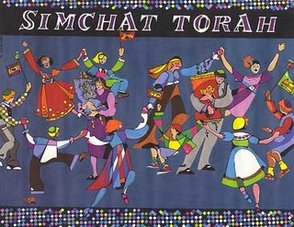Simchat Torah
Simchat Torah and Shemini Atzeret.

Simchat Torah and Shemini Atzeret 22nd Tishri are one day. In Israel, where Simchat Torah is not celebrated on a separate day – since all Festivals are observed for a single day, the customs of Simchat Torah are observed together with those of Shemini Atzeret. This practice is observed by Liberal congregations.
Simchat Torah comes on the last day of the festivities. At this time the last portion of the Torah is read, and since we never finish the Torah reading, we begin the reading from the very beginning again to show the Torah is beloved to us like a “new command to which everyone runs”. This is a very happy occasion. All the Torah scrolls are taken from the Ark and carried in a parade around the synagogue seven times. We rejoice, sing and dance with the Torahs, for the reestablishment of our covenant with the Torah as a groom rejoices with his bride.
If a man is called to read the last few lines of Deuteronomy, he is called the Chatan Torah (groom of the Torah) and if a woman is called up, she is called the Kallah Torah (bride of the Torah). Likewise, the male readers of the beginning of Genesis are referred to as the Chatan Bereshit (groom of creation) and female readers are referred to as the Kallah Bereshit (bride of creation).
The last passages of Deuteronomy chronicle the death of Moses. In some way, Simchat Torah honours Moses’ death, but the day also clearly ties the death to the first chapter of Genesis: the Creation of the universe. In this way, Simchat Torah also reminds people that life transcends death and that the world is a never ending cycle of death and rebirth.
